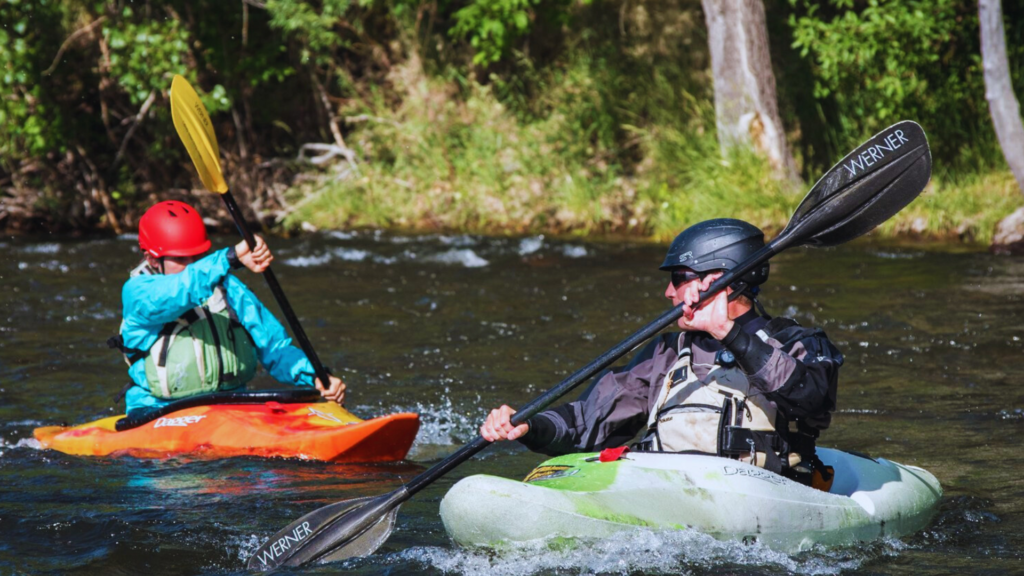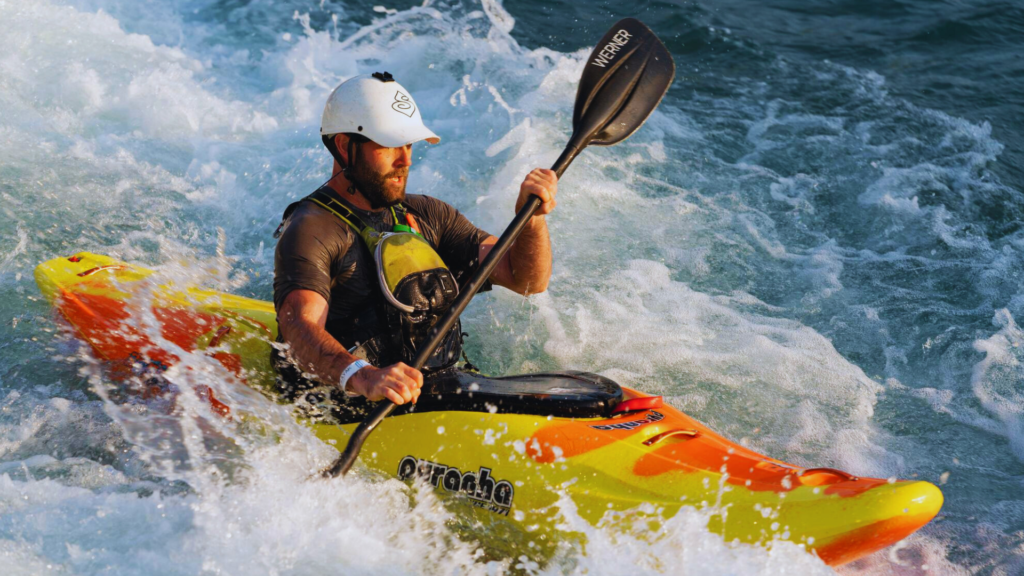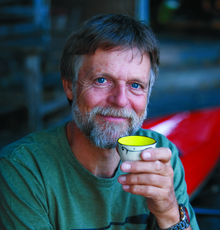Kayaking is more than just a leisurely paddle across a lake or down a river; it’s an intricate dance between the paddler, the kayak, and the water. When a person in a kayak starts paddling and it accelerates, it’s a result of fascinating physics at play, combined with skill and strength. This article will delve into the mechanics of how a kayak moves, the factors that affect its acceleration, and the techniques that can help any kayaker improve their speed and control.
Whether you’re a seasoned kayaker or new to the sport, understanding the dynamics of acceleration will enhance your experience on the water. So, let’s embark on this journey to uncover the secrets of swift paddling and the joy of gliding swiftly over the water’s surface.
Table of Contents
Understanding Kayak Acceleration
Basics of Kayak Dynamics
The kayak, a slender and lightweight vessel, is designed to cut through water with minimal resistance. Its shape, often long and narrow, allows it to move efficiently when a person starts paddling. The paddle acts as an extension of the kayaker’s arms, pulling the water backward to propel the kayak forward. This action is a clear example of Newton’s third law of motion: for every action, there is an equal and opposite reaction.
Factors Affecting Kayak Acceleration
Several factors come into play when considering how quickly a kayak accelerates. The design of the kayak, including its length, width, and hull shape, directly impacts its speed potential. A longer and narrower kayak will typically be faster than a shorter, wider one. The paddler’s technique is also crucial; efficient strokes that maximize power and minimize wasted energy will lead to quicker acceleration. Additionally, the conditions of the water, such as current and wind, can either aid or hinder the kayak’s movement.
Paddler’s Guide to Accelerating a Kayak

Essential Paddling Techniques for Speed
To achieve rapid acceleration, a person in a kayak must master the forward stroke. This involves planting the paddle blade firmly in the water near the kayak’s bow and pulling it back alongside the hull to the hip. The angle of the blade and the paddler’s torso rotation play significant roles in the effectiveness of each stroke.
Building Up Paddling Strength and Endurance
Strength and endurance are vital for sustained acceleration. Paddlers can improve their paddling power through targeted exercises such as push-ups, pull-ups, and core workouts. Additionally, practicing longer paddling sessions will build endurance, allowing for consistent speed over time.
Science Behind Paddling and Acceleration
Physics in Action: Force, Drag, and Motion
When a person in a kayak starts paddling and it accelerates, it’s a practical demonstration of fundamental physics. The force applied by the paddler to the paddle creates a reaction force that propels the kayak forward. This is an application of Newton’s second law of motion, which states that

, where ( F ) is the force applied, ( m ) is the mass of the kayak, and ( a ) is the acceleration produced.
However, as the kayak moves, it encounters resistance from the water, known as drag. Drag is influenced by factors such as the kayak’s speed, the shape of the kayak, and the water’s density. The equation for drag force is given by

, where ( F_d ) is the drag force, ( \rho ) is the water density, ( v ) is the velocity of the kayak, ( C_d ) is the drag coefficient, and ( A ) is the cross-sectional area of the kayak.
Measuring Acceleration in a Kayak
To measure acceleration, kayakers can use GPS devices or smartphone apps that track speed over time. By analyzing the data, paddlers can understand their acceleration patterns and identify areas for improvement. For instance, a consistent increase in speed after each stroke indicates efficient paddling, while fluctuations might suggest a need for technique refinement.
Physics of Kayak Acceleration: Calculating the Forces at Play
When a person in a kayak starts paddling and it accelerates, it’s not just about the physical effort; it’s also about the fascinating interplay of forces. To understand this better, let’s delve into a practical example that illustrates the physics behind the acceleration of a kayak.
Imagine a scenario where a kayaker accelerates from a standstill to a speed of 0.60 m/s over a distance of 0.41 m. If the combined mass of the kayaker and the kayak is 73 kg, we can calculate the net force required to achieve this acceleration.
Using the work-energy principle, we know that the work done on the kayak is equal to the change in kinetic energy:

Given that the initial velocity (( v_i )) is 0 (since the kayak starts from rest) and the final velocity (( v_f )) is 0.60 m/s, we can plug in the values to find the work done:

The work done is also equal to the force times the distance (( W = F \times d )), so we can find the net force (( F )) by rearranging the equation:

Therefore, the magnitude of the net force acting on the kayak to achieve this acceleration is 32.05 N.
This example demonstrates the direct application of physics in the sport of kayaking. By understanding these principles, kayakers can better grasp how their movements and the environment affect their speed and acceleration on the water.
Safety Measures and Acceleration Control
Navigating Waters Safely While Paddling Fast
Safety should always be a priority, especially when attempting to increase speed. A person in a kayak must be equipped with a life jacket, a helmet (if in rough waters), and possibly a GPS device for navigation. It’s also important to learn how to control the kayak at high speeds to avoid capsizing. Techniques such as the low brace and high brace can help maintain stability.
Dealing with External Factors
External factors like weather and wildlife can impact kayaking performance and safety. Before heading out, check the weather forecast and plan accordingly. Be aware of the local wildlife and know how to react if you encounter animals while on the water.
Advanced Paddling Techniques for Maximum Acceleration

Expert Tips for Faster Kayak Acceleration
For those looking to push their limits, understanding and mastering advanced paddling techniques can lead to significant gains in acceleration. A person in a kayak who starts paddling with advanced strokes will notice a quicker response and greater speed. Techniques such as the wing paddle stroke, which utilizes a wing-shaped blade to catch more water, can increase propulsion efficiency. Additionally, implementing a power phase at the beginning of the stroke, where the paddler applies the most force, can also contribute to a faster acceleration.
Training Regimens for Competitive Paddlers
Competitive kayakers often follow structured training regimens that focus on building strength, endurance, and technique. A typical regimen might include interval training on the water, where paddlers alternate between high-speed bursts and rest periods. Cross-training activities like cycling, swimming, and weightlifting can also enhance overall athletic performance, benefiting kayaking capabilities.
Conclusion
Throughout this article, we’ve explored the various aspects of how a person in a kayak starts paddling and it accelerates. From the basic dynamics of kayaking to advanced techniques for competitive paddling, we’ve covered the essential knowledge every kayaker should know. Remember, practice is key to mastering these skills, and with time and dedication, the thrill of acceleration will become a familiar sensation.
Most Common Questions
What causes a kayak to accelerate when a person starts paddling?
A kayak accelerates due to the force exerted by the paddler’s strokes against the water. This force propels the kayak forward, following Newton’s third law of motion.
How does the design of a kayak affect its acceleration?
The shape, length, and width of a kayak can significantly influence its speed and acceleration. A longer and narrower kayak is typically designed for faster acceleration and higher speeds.
Can water conditions affect how quickly a kayak accelerates?
Yes, water conditions such as currents, waves, and wind can impact the kayak’s acceleration. Calm waters generally allow for better acceleration compared to rough conditions.
What are some techniques to improve kayak acceleration?
Improving your forward stroke technique, increasing paddle blade angle efficiency, and building paddling strength and endurance can all contribute to better acceleration.
Is it important to measure acceleration while kayaking?
Measuring acceleration can help kayakers understand their performance and identify areas for improvement. It can also be useful for competitive paddlers looking to increase their speed.
What safety measures should be taken when trying to accelerate a kayak?
Always wear a life jacket, consider a helmet in rough waters, and ensure you have the skills to control the kayak at higher speeds. Being aware of weather and water conditions is also crucial.
Are there advanced paddling techniques for experienced kayakers to increase acceleration?
Yes, advanced techniques like the wing paddle stroke and power phase can help experienced paddlers achieve greater acceleration and speed.

Nigel Foster, born in 1952, is an esteemed sea kayaker, known for being the youngest to kayak around Iceland. His journey in kayaking started at 15 in Brighton, England. With a career beginning as a trainee instructor in Sussex, he later pursued teaching after attending Redland College, Bristol.
Foster’s notable expeditions include navigating the challenging waters of Newfoundland and the Hudson Strait. Despite facing intense conditions, his passion for kayaking never waned. He holds several British Canoe Union qualifications and has significantly contributed to the kayaking community through teaching and committee work.
In 1985, Foster expanded his horizons by assisting an expedition in Iceland and later founded his own kayaking business, sharing his expertise globally.
